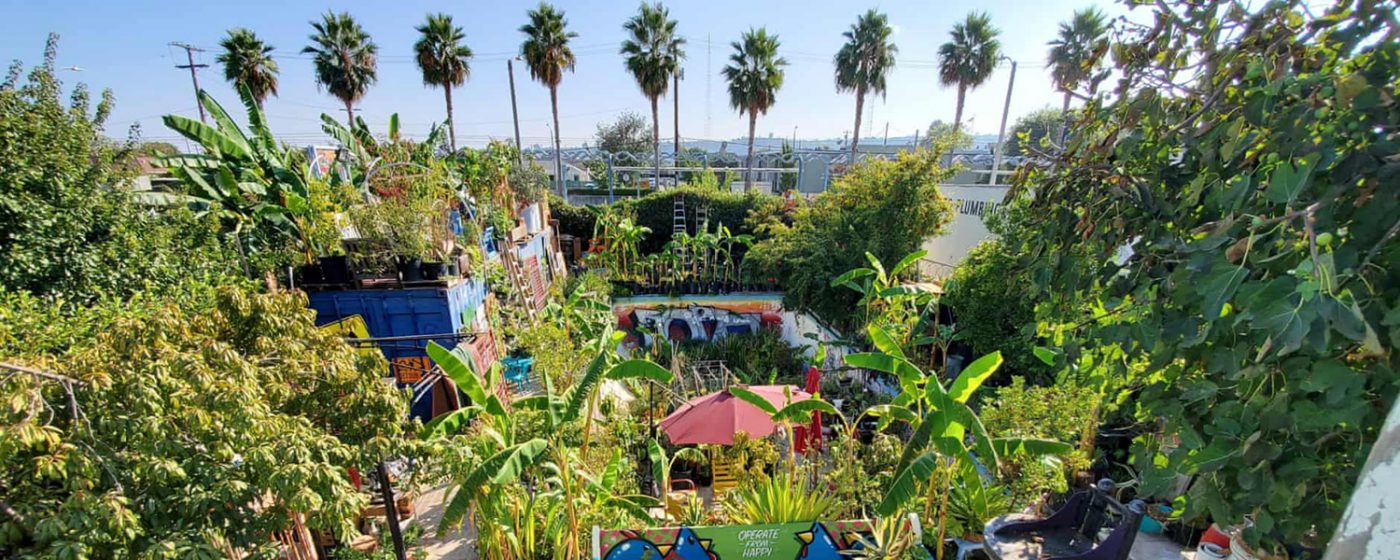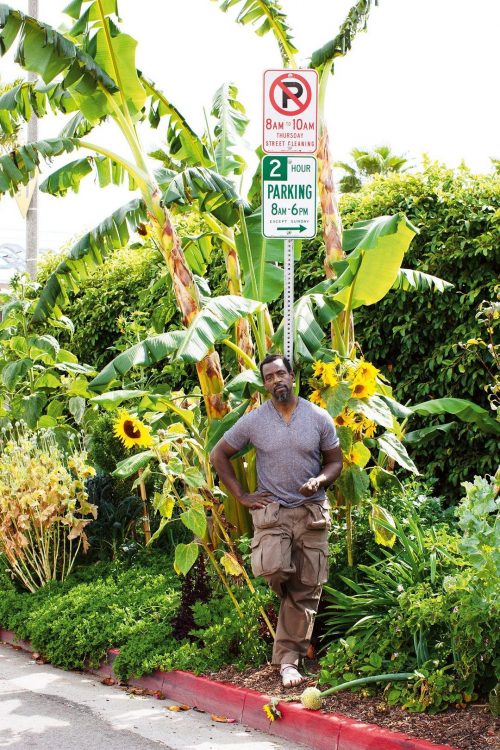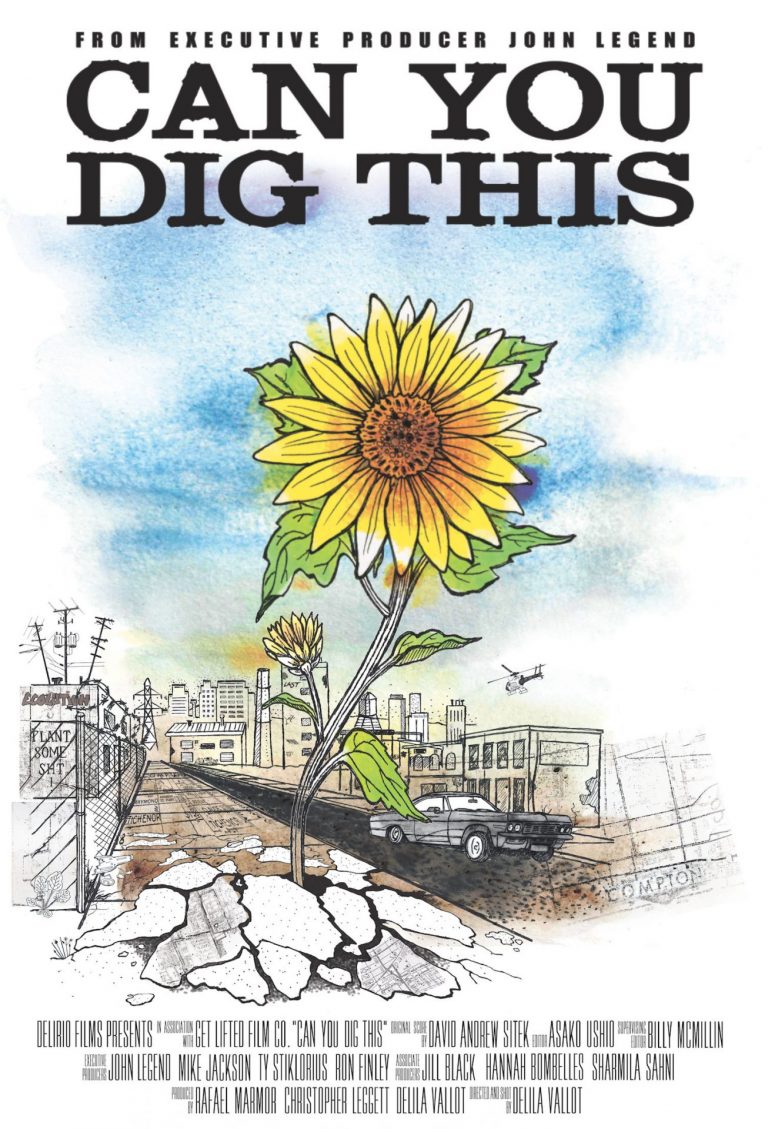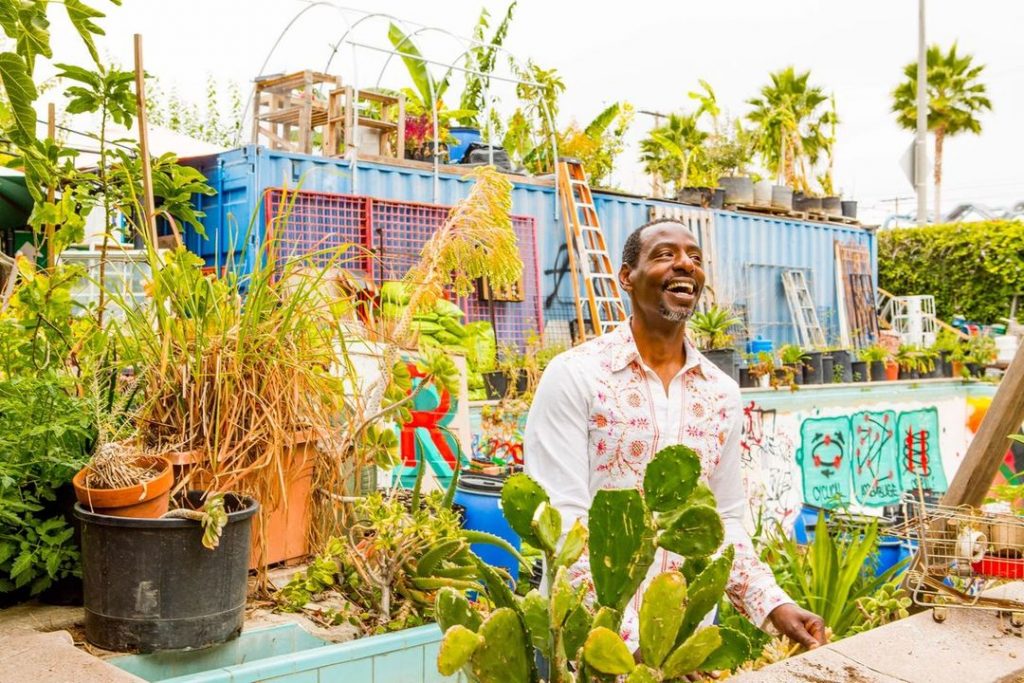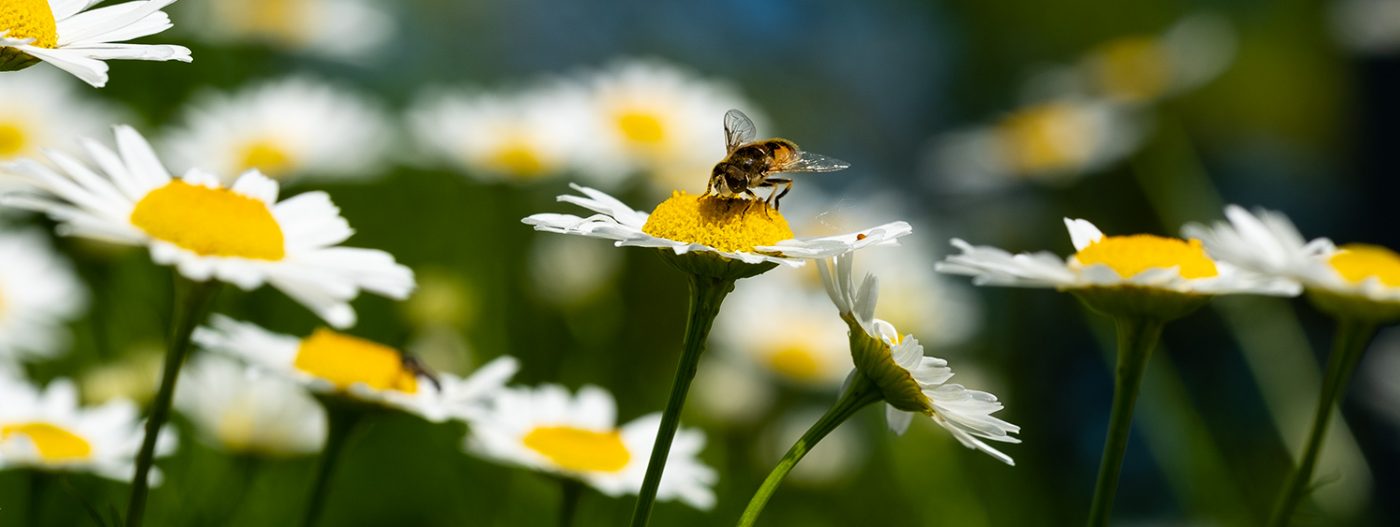Originally produced for Arts Help, Summer 2021
Artist and gardener Ron Finley uses soil for his canvas and plants and trees for his paint.
“Gardening is my graffiti. I grow my own art. I beautify lawns and parkways.”
Ten years ago there was a warrant out for the arrest of Ron Finley for the crime of planting food. Finley lives in South Central Los Angeles best known for crippling poverty and gang violence. After the recession of 2008, Finley’s work as a fashion designer dried up and times were tough. There was a patch of unused grass on his parkway, (a small patch of land between the sidewalk and the street), that he was technically responsible for, so he decided to plant a food forest.
But then a neighbour complained and the city descended. So long as it remained dried up grass and covered in garbage, the city didn’t care. However, when he turned it into a garden of banana trees, kale and sunflowers, it was now against the law. Finley refused to back down and with some media attention and a lot of determination he was able to get the law changed. And the Garden Gangsta, as he is now called, was born.
Finley is a charming and incredibly focused activist who isn’t afraid to tell it like it is with colourful language. As a gardener, he is largely self-taught. Though he has managed to make a good living in an otherwise depressed area, he knows how much many of his neighbours struggle to get by, let alone eat healthy food.
As he describes in both his TED talk and on his website, South Central is made up of fast-food restaurants, liquor stores and vacant lots. The obesity rates are 5 times higher than in northern Los Angeles which is only 7 or so miles away. Drop-in dialysis clinics are everywhere. Technically, it is known as a food desert, an area where you have to drive a long distance to purchase healthy food. Over 23 million people in the United States live in these areas.
When Finlay realized that the food available to him, even after he drove 45 mins, was covered in chemicals, he knew he had to grow his own food. That set him on a journey of exploration, learning and community engagement.
On his parkway garden, he would witness people stopping by to ask what he was doing. They had become so detached from what they eat that they didn’t know what food looked like while it was growing. He knew then that a garden could be a tool for education, a tool to transform his neighbourhood. As he describes in his TED talk, children will blindly eat what you put in front of them. Teach them to grow kale and they will eat kale. They are the future; they have the ability to create a more sustainable world. In a article for Vogue by Christian Allaire, Finley states,
“When you learn how to cultivate your own food, that’s freedom,” Finley says. “The way I see it, we are gardens. We are nature. I’m trying to change what people value: what we value in each other, and in humanity.”
In 2010, he and a few other gardeners formed Green Grounds, a volunteer group that encourages community groups to create gardens in their area. Though it’s working, there is a lot of work yet to do.
In South Central, the city owns 26 square miles of vacant lots. That works out to be 20 Central Parks of land that could be put to use for the community. The area has been the victim of active racist development policies (called Red Lining) for decades.
In the June 2021 copy of National Geographic, Alejandra Borunda illustrates in detail how development policies were determined by economic status and race. Northern areas like Hollywood were given parks and tree-lined streets. Southern areas, made up of largely black, Hispanic and Jewish populations, were neglected and no money was allocated to maintain green spaces. In many cases, trees were removed so that the police helicopters could track alleged criminals.
This resulted in a sun-baked neighbourhood of mostly concrete and asphalt that trends 7-10 degrees hotter than Hollywood. And as the climate continues to warm, this will only get worse. The development policy is starting to change, however, trees planted for shade take time to grow. Community food gardens could solve multiple issues from giving people a life off the streets, improving their health, and reducing the temperature of the neighbourhood.
As Finley says, “Gardening is the most therapeutic and defiant act you can do, especially in the inner cities, plus you get strawberries.”
Finley’s message aligns well with the United Nations Sustainability Development Goal (SDG) 10 concerning reducing inequalities and SDG 15 concerning life on land. Social inequality threatens economic development but it also can destroy people’s sense of self-worth. Lack of self-worth can lead to serious health issues and crime.
This is illustrated in the movie about Ron Finley and his neighbourhood, Can You Dig This, directed by Delila Vallot. The movie follows four people who have been encouraged to try their hand at gardening and how it changed their life. In each case, gardening proves to be transformative, giving the individuals purpose and opportunity.
The Green Grounds volunteers continue to educate and transform South Central LA with the community garden programs. Finley eventually created The Ron Finley Project to spread his message of empowerment by growing your own food. He has been incredibly influential both at home and around the world. His TED talk has been viewed more than 4 million times. In 2020, his Masterclass in Gardening came out, amazingly timely during COVID-19 when everyone was trying their hand at growing their own food.
And finally, the fashion designer/gardener has come full circle by creating a line of casual unisex clothes that are of course, perfect for working in the garden. Collaborating with Everybody World, the clothes are sustainably made in Los Angeles from recycled cotton. Proceeds from the sales will be used as fundraising for The Ron Finley Project.
On the Everybody World website, he said,
“There is no trash, there’s only art waiting to happen and that’s what I love about what we have done.”
Many gardeners choose to develop picture-perfect landscapes. But that is not Finley’s style. In his backyard, there is a pool he couldn’t afford to fill and maintain. So he filled it with potted plants instead. Gardening doesn’t have to be expensive, you can grow food in any kind of container and it will still be beautiful.
As he says in an article for The Guardian, “Mother Nature is the greatest artist out there.”
You can read more about and donate to The Ron Finley Project here.
You can rent the movie, Can You Dig This, on AppleTV.
To learn more about and donate to Green Grounds click here.
- Always carry your own bags, water bottle, and coffee mug
- Drive an electric vehicle or better yet take transit or your bike
- Only buy local food (to avoid emissions from transportation)
- Buy organic (to avoid chemicals used in fertilizing and pesticides)
- Eat less meat or go vegetarian or vegan
- Pay attention to the packaging on products and only buy things in recyclable or reusable packages (avoid plastic that can’t be recycled easily or just avoid plastic altogether)
- Turn off your lights and any device you are not using, even unplugging them to avoid “phantom power” usage
- Change your light bulbs to low energy LEDs
- Switch to solar panels or make sure your grid power comes from renewable sources
- Stop buying fast fashion (buy only clothes, shoes and accessories made from organic or recycled products)
- Only buy products made of materials that can be easily recycled
- Reduce, reuse, repurpose
These are all great things and I endeavour to do them every day in some way. But making these choices takes time, money, and energy, putting a great deal of the burden on the consumer.
To be truly sustainable you must not purchase anything that might in some way harm the environment. Everything we consume to survive must go back into the cycle of production and never be allowed to pollute the air or poison the rivers and oceans.
In this day and age, this is impossible. Almost everything we buy, at either its production or its disposal, is hard on the planet.
Take something as recyclable as paper. Paper has been around for centuries. It can be made from almost anything but is primarily made from trees. Trees are being cut down faster than they can regrow. But we can recycle paper, right? Well, not if it has been contaminated by food or liquids or if it has been covered in wax. Then it just goes into the landfill.
What about that electric car? It’s good for the environment in that it doesn’t spew carbon monoxide into the air. But every component of that car is made of petroleum products. From the plastic dashboard to the rubber tires, to the polyester or vinyl fabric seats, the production of that car is an environmental crime. Yes, some of it can be recycled but most of it can’t.
The batteries powering your cell phone use the metal lithium-ion, the mining of which is polluting both air and water sources around the world. Your typical toilet paper is treated with bleach. Even producing a simple pair of cotton jeans requires enormous amounts of water, pesticides, and chemicals. I could go on and on.
When you really look at how each product on the market is made, and how far it had to travel to get to your door, it is almost impossible to find one that is 100 per cent sustainable.
It is overwhelming. And for someone who has chosen to live with this awareness, it is demoralizing. Where do you even start? If I can’t do it properly, how can I encourage others to do the same?
The environmental movement, as we know it today, has been around for over 30 years. People with much more knowledge than me have been fighting this fight and getting almost nowhere.
Why should anyone even bother?
The morning after our conversation my husband produced a quote for me to think about. It’s not a direct quote from Martin Luther King but more of a synopsis from one of his.
Our lives begin to end the day we become silent about things that matter.
Meaning, life is only worth living when you live with purpose and act on that purpose. Let’s bring it all back to this land we live on. To quote Audrey Hepburn;
To plant a garden is to believe in tomorrow.
Nature is the centre of it all. We need it to survive. Generations in the future will need it to survive. What we are doing to this planet, pillaging its resources and polluting the air and water is untenable. If we continue as we are, there will be nothing left to support us.
Awareness of the problem is the first step. Spreading the word, including the struggles, is essential to the movement.
It took women 100 years to get the vote and not until the 70s before they could open their own bank account without the permission of their husbands. Technically, black African Americans got the right to vote in the mid-1800s but in many states that right was not properly realized until the 60s and continues to be challenged today.
Being a force for change takes time and requires actions both large and small. Every person has to figure out what they can do in their own lives. We have started with education, lifestyle choices and growing some of our own food. It’s not much but it is a start.
And I will continue to speak about these things until people start to listen.
I suspect the planet will be the loudest voice in the years to come, telling us with storms, famine, and viruses what we are doing wrong and finally dragging us, kicking and screaming, into the next era.

